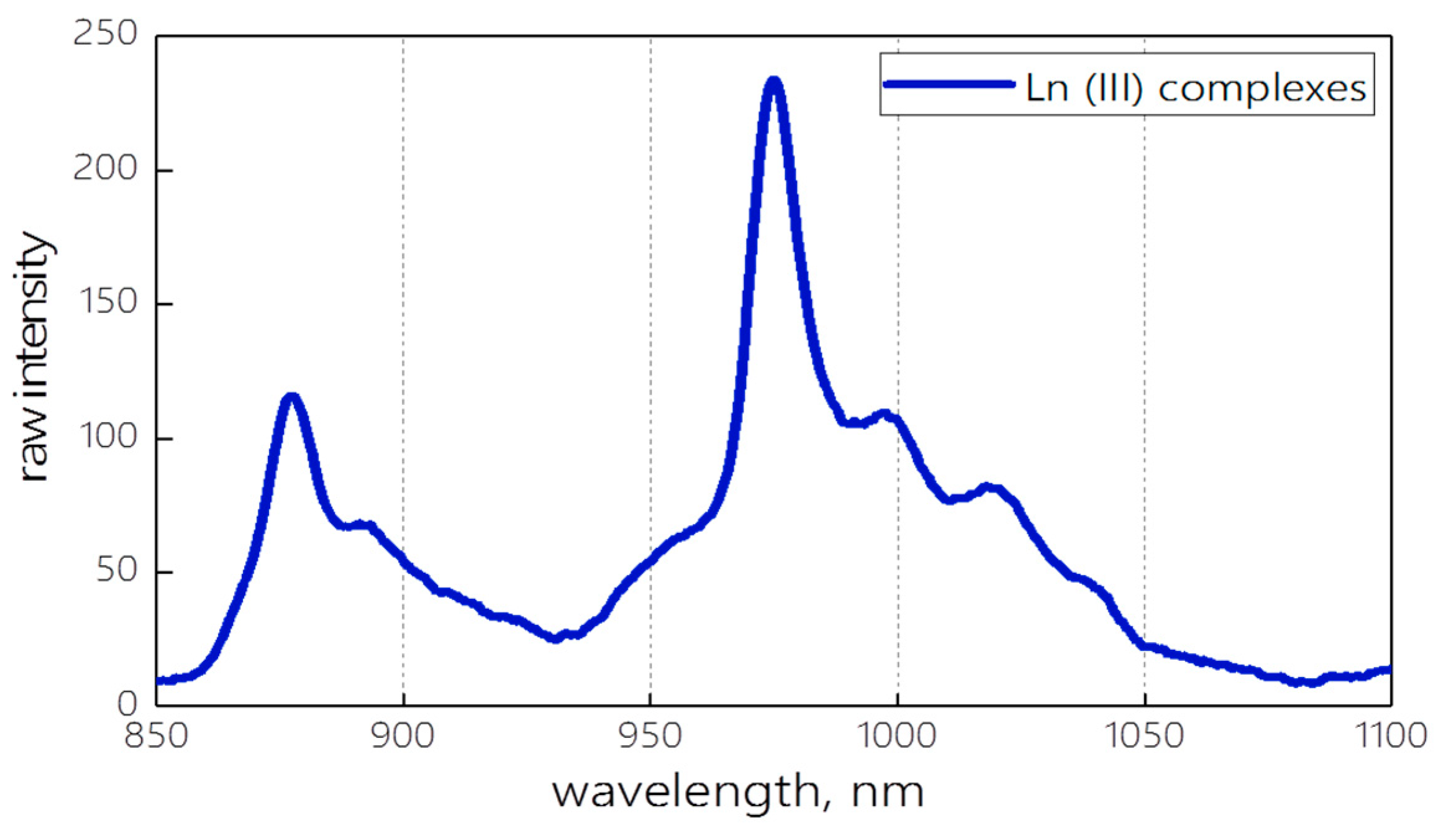Milk Analysis using a New Optical Multisensor System Based on Lanthanide(III) Complexes †
Abstract
:1. Introduction
2. Complexes
3. Design of OMS
4. Practical Application of the OMS
5. Conclusions
Author Contributions
Funding
Institutional Review Board Statement
Informed Consent Statement
Data Availability Statement
Conflicts of Interest
References
- Skibsted, E.; Engelsen, S.B. Spectroscopy for process analytical technology (PAT). Spectrosc. Lett. 2017, 3, 188e197. [Google Scholar] [CrossRef]
- Rolinger, L.; Rüdt, M.; Hubbuch, J. A critical review of recent trends, and a future perspective of optical spectroscopy as PAT in biopharmaceutical downstream processing. Anal. Bioanal. Chem. 2020, 412, 2047–2064. [Google Scholar] [CrossRef] [PubMed]
- Pampuri, A.; Tugnolo, A.; Giovenzana, V.; Casson, A.; Guidetti, R.; Beghi, R. Design of cost-effective LED based prototypes for the evaluation of grape (Vitis vinifera L.) ripeness. Comput. Electron. Agric. 2021, 189, 106381. [Google Scholar] [CrossRef]
- Civelli, R.; Giovenzana, V.; Beghi, R.; Naldi, E.; Guidetti, R.; Oberti, R. A simplified, light emitting diode (LED) based, modular system to be used for the rapid evaluation of fruit and vegetable quality: Development and validation on dye solutions. Sensors 2015, 15, 22705–22723. [Google Scholar] [CrossRef] [PubMed]
- Lastra-Mejias, M.; Villa-Martinez, A.; Izquierdo, M.; Aroca-Santos, R.; Cancilla, J.C.; Torrecilla, J.S. Combination of LEDs and cognitive modeling to quantify sheep cheese whey in watercourses. Talanta 2019, 203, 290–296. [Google Scholar] [CrossRef]
- Yeh, P.; Yeh, N.; Lee, C.-H.; Ding, T.-J. Applications of LEDs in optical sensors and chemical sensing device for detection of biochemicals, heavy metals, and environmental nutrients. Renew. Sustain. Energy Rev. 2017, 75, 461–468. [Google Scholar] [CrossRef]
- Sohrabi, H.; Hemmati, A.; Majidi, M.R.; Eyvazi, S.; Jahanban-Esfahlan, A.; Baradaran, B. Recent advances on portable sensing and biosensing assays applied for detection of main chemical and biological pollutant agents in water samples: A critical review. Trends Anal. Chem. 2021, 143, 116344. [Google Scholar] [CrossRef]
- Negi, S.; Mittal, P.; Kumar, B.; Juneja, P.K. Organic LED based light sensor for detection of ovarian cancer. Microelectron. Eng. 2019, 218, 111154. [Google Scholar] [CrossRef]
- Costa-Fernandez, J.M.; García, C.M.; Soldado, A. Optical (Bio)Sensors in medical diagnosis. Biomaterials 2023, 4, 297–316. [Google Scholar] [CrossRef]
- Bogomolov, A. Developing multisensory approach to the optical spectral analysis. Sensors 2021, 21, 3541. [Google Scholar] [CrossRef] [PubMed]
- Surkova, A.; Bogomolov, A.; Paderina, A.; Khistiaeva, V.; Boichenko, E.; Grachova, E.; Kirsanov, D. Optical multisensor system based on lanthanide(III) complexes as near-infrared light sources for analysis of milk. Chemosensors 2022, 10, 288. [Google Scholar] [CrossRef]
- Khistiaeva, V.V.; Melnikov, A.S.; Slavova, S.O.; Sizov, V.V.; Starova, G.L.; Koshevoy, I.O.; Grachova, E.V. Heteroleptic -diketonate Ln(III) complexes decorated with pyridyl substituted pyridazine ligands: Synthesis, structure and luminescence properties. Inorg. Chem. Front. 2018, 5, 3015. [Google Scholar] [CrossRef]
- Ezhilan, M.; Gumpu, M.B.; Ramachandra, B.L.; Nesakumar, N.; Babu, K.J.; Krishnan, U.M.; Rayappan, J.B.B. Design and development of electrochemical biosensor for the simultaneous detection of melamine and urea in adulterated milk samples. Sens. Actuators B Chem. 2017, 238, 1283–1292. [Google Scholar] [CrossRef]
- Siesler, H.W.; Kawata, S.; Heise, H.M.; Ozaki, Y. Near-Infrared Spectroscopy: Principles, Instruments, Applications, 1st ed.; Wiley-VCH: Weinheim, Germany, 2002. [Google Scholar]
- Gitlina, A.Y.; Surkova, A.; Ivonina, M.V.; Sizov, V.V.; Petrovskii, S.; Legin, A.; Starova, G.L..; Koshevoy, I.O.; Grachova, E.V.; Kirsanov, D.O. Cyclometalated Ir(III) complexes as tuneable multiband light sources for optical multisensor systems: Feasibility study. Dyes Pigm. 2020, 180, 108428. [Google Scholar] [CrossRef]
- Surkova, A.A.; Paderina, A.V.; Legin, A.V.; Grachova, E.V.; Kirsanov, D.O. Cu(I)-based molecular emitters for quantification of fluoride and phosphate in surface waters. Measurement 2021, 184, 109976. [Google Scholar] [CrossRef]


| Calibration | Cross-Validation | ||||
|---|---|---|---|---|---|
| Spec, % | Sens, % | Acc. % | Spec, % | Sens, % | Ac, % |
| 1 | 1 | 1 | 0.88 | 0.9 | 0.89 |
Disclaimer/Publisher’s Note: The statements, opinions and data contained in all publications are solely those of the individual author(s) and contributor(s) and not of MDPI and/or the editor(s). MDPI and/or the editor(s) disclaim responsibility for any injury to people or property resulting from any ideas, methods, instructions or products referred to in the content. |
© 2023 by the authors. Licensee MDPI, Basel, Switzerland. This article is an open access article distributed under the terms and conditions of the Creative Commons Attribution (CC BY) license (https://creativecommons.org/licenses/by/4.0/).
Share and Cite
Surkova, A.; Bogomolov, A.; Paderina, A.; Khistiaeva, V.; Boichenko, E.; Grachova, E.; Kirsanov, D. Milk Analysis using a New Optical Multisensor System Based on Lanthanide(III) Complexes. Eng. Proc. 2023, 48, 28. https://doi.org/10.3390/CSAC2023-14923
Surkova A, Bogomolov A, Paderina A, Khistiaeva V, Boichenko E, Grachova E, Kirsanov D. Milk Analysis using a New Optical Multisensor System Based on Lanthanide(III) Complexes. Engineering Proceedings. 2023; 48(1):28. https://doi.org/10.3390/CSAC2023-14923
Chicago/Turabian StyleSurkova, Anastasiia, Andrey Bogomolov, Aleksandra Paderina, Viktoria Khistiaeva, Ekaterina Boichenko, Elena Grachova, and Dmitry Kirsanov. 2023. "Milk Analysis using a New Optical Multisensor System Based on Lanthanide(III) Complexes" Engineering Proceedings 48, no. 1: 28. https://doi.org/10.3390/CSAC2023-14923
APA StyleSurkova, A., Bogomolov, A., Paderina, A., Khistiaeva, V., Boichenko, E., Grachova, E., & Kirsanov, D. (2023). Milk Analysis using a New Optical Multisensor System Based on Lanthanide(III) Complexes. Engineering Proceedings, 48(1), 28. https://doi.org/10.3390/CSAC2023-14923









